Could the Bible's mysterious events hint at extraterrestrial encounters? Discover more about these intriguing possibilities.
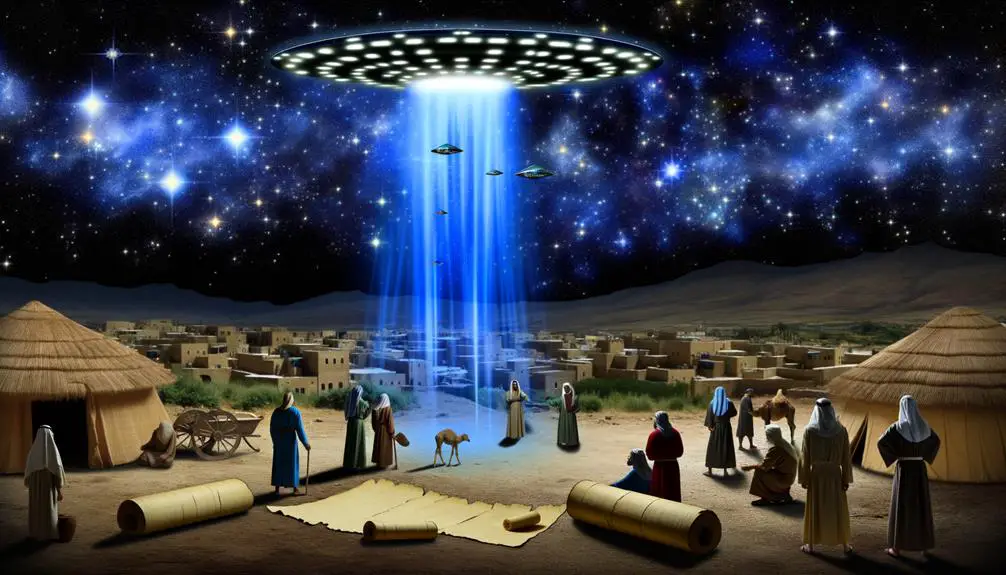
Extraterrestrial in the Bible
You may find it intriguing that the Bible hosts various narratives which proponents argue could indicate extraterrestrial influences. Accounts like Elijah's fiery ascent in a chariot, Ezekiel's vision of a wheel-within-wheel structure, and descriptions of angelic beings with unearthly features suggest more than mere symbols. These descriptions often correlate with modern interpretations of extraterrestrial encounters. Such narratives historically contribute to debates on whether these accounts are of divine origin or possibly encounters with otherworldly visitors. These analyses offer a foundation for further exploration into how these biblical events might transcend our typical understanding of spiritual phenomena. You'll certainly find deeper insights as you explore further.
Key Takeaways
- Biblical texts like Ezekiel's vision describe complex, otherworldly crafts, hinting at possible extraterrestrial technology.
- Elijah's ascent in a fiery chariot can be interpreted as an encounter with an advanced extraterrestrial vehicle.
- Angels described in the Bible with extraordinary abilities and appearances may resemble modern depictions of aliens.
- The Star of Bethlehem is often reevaluated for its astronomical origins, suggesting a celestial phenomenon rather than a supernatural event.
- Events like the destruction of Sodom and Gomorrah involve descriptions that some interpret as involving advanced, possibly extraterrestrial, technology.
Ancient Astronaut Theories Explored
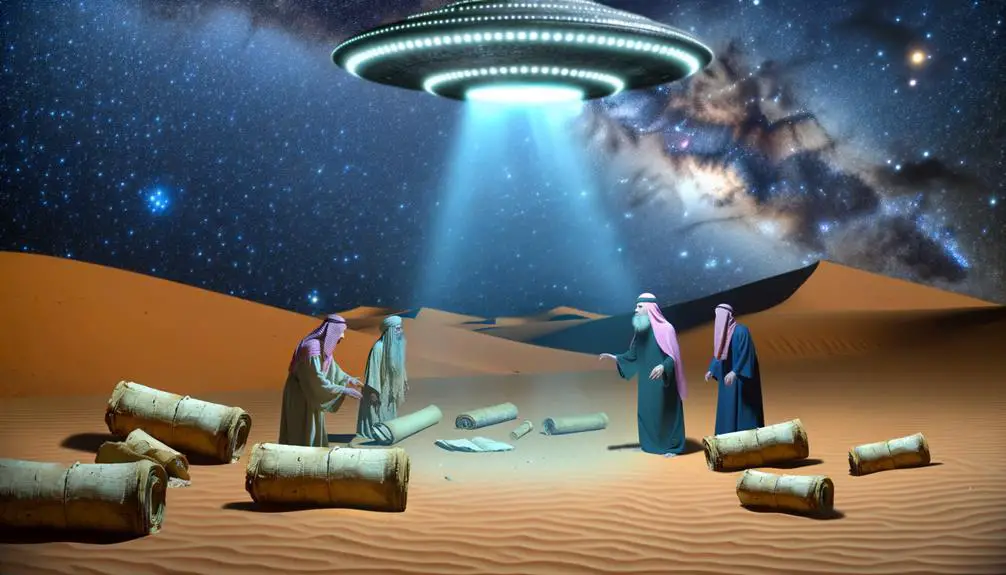
In exploring ancient astronaut theories, you'll find that proponents argue these entities influenced early human civilizations, embedding their presence in cultural and religious texts. You might wonder how this interpretation arises from historical accounts and archaeological findings. Scholars in this field often point to UFO sightings documented in ancient scripts, suggesting that what were once considered celestial or divine phenomena might actually be evidence of alien technology.
When examining such claims, it's important to approach with a critical but open mind. Proponents cite artifacts and monuments whose construction perplexes modern engineers and historians alike, arguing these could not have been achieved without advanced knowledge or capabilities, possibly provided by extraterrestrial visitors. For instance, the precision in the layout of the pyramids or the massive stones perfectly fitted together in ancient structures—these feats, they suggest, hint at the application of alien technology.
However, while the notion is intriguing, evidence remains interpretative rather than conclusive. Therefore, as you explore further, maintain a balance between skepticism and curiosity. This analytical journey isn't just about proving or disproving, but understanding the broader implications such interpretations could have on our understanding of human history and progress.
The Vision of Ezekiel Analyzed
When contemplating the Vision of Ezekiel, it is crucial to scrutinize the detailed depiction of Ezekiel's chariot, a central element that has sparked various interpretations. Scholars debate whether these descriptions point to divine revelation or possible extraterrestrial encounters, analyzing the text within historical and cultural contexts. Understanding these interpretations helps clarify whether they stem from theological symbolism or suggest otherworldly visitations.
Ezekiel's Chariot Description
Ezekiel's description of a chariot, deeply analyzed, reveals a complex vision that's rich with symbolic elements and potential extraterrestrial interpretations. You'll notice the recurring themes of 'Cherubim symbolism' and 'Visionary wheels,' which are central to understanding this prophetic imagery. The Cherubim, often depicted with multiple faces and wings, signify a multidimensional aspect that transcends normal earthly entities. Their appearance suggests a form not just of celestial beings but perhaps beings of another world, sophisticated beyond our understanding.
The wheels that accompany these Cherubim are not ordinary; described as wheels within wheels, full of eyes all around, they epitomize the intricacies of a possibly advanced technology, steering beyond conventional physics and into a domain that blurs the divine with the cosmic.
Interpretations of Ezekiel's Vision
While considering the myriad interpretations of Ezekiel's vision, it's important to acknowledge how scholars and theologians have diverged in their analysis, ranging from strictly spiritual metaphors to suggestive extraterrestrial theories. You'll find that most traditional interpretations lean towards viewing these descriptions as divine encounters, emphasizing prophetic symbolism embedded within the texts. This perspective suggests that Ezekiel's experiences and the vivid imagery used were intended to convey deeper spiritual truths, perhaps messages from God tailored for his people during that era. However, the extraterrestrial hypothesis presents an alternative reading, positing that the detailed descriptions of flying chariots and creatures might be an ancient account of contact with otherworldly beings. Each interpretation offers its own unique lens through which to view this complex biblical narrative.
Elijah's Fiery Ascension
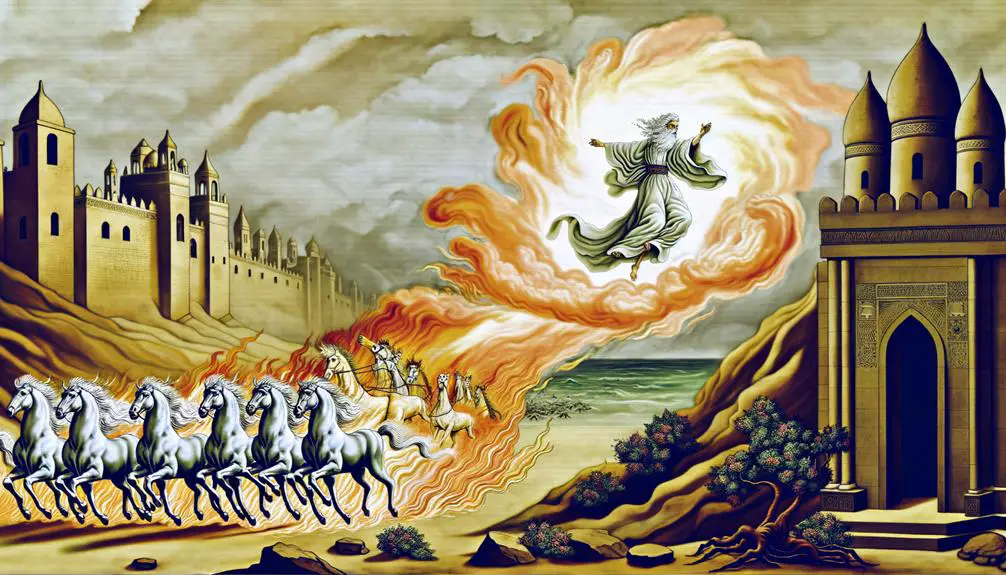
Elijah's fiery ascension to heaven, as depicted in the Bible, challenges our understanding of ancient texts and their portrayal of divine interventions. This biblical event, rich with prophetic symbolism, invites you to contemplate the profound layers embedded within these ancient narratives. The fiery chariot, which swept Elijah into the sky, isn't merely a vehicle but a symbol loaded with theological significance, signifying divine presence and approval.
Delving into the chariot mechanics, you find that these descriptions may not just be fantastical elements but could serve as metaphoric representations of extraordinary, perhaps divine, technology or knowledge. The text describes how a whirlwind took Elijah up to heaven in a chariot of fire, a scene that merges the miraculous with the mysterious. This depiction pushes you to reflect on how ancient people interpreted events and entities beyond their scientific understanding.
Elijah's departure is not just an isolated incident but a narrative woven with messages meant to inspire, admonish, or guide the ancient audiences. As you analyze these texts, it becomes evident that such stories might have served multiple purposes: reinforcing moral lessons, legitimizing prophetic authority, or symbolizing spiritual upliftment. Through scholarly exploration, you gain insights into how these narratives functioned within their cultural and historical contexts.
Angels or Alien Encounters?
As you explore the subtopic of 'Angels or Alien Encounters?', consider the descriptions found in Biblical texts: do they suggest encounters with beings possessing traits typically ascribed to extraterrestrials? Reflect on accounts of angelic visits; could these narratives align with modern interpretations of UFO sightings? Analyzing these ancient texts within a contemporary framework offers a unique perspective on their potential meanings and origins.
Biblical Descriptions: Alien Traits?
In examining biblical texts, you might find that descriptions of angels share intriguing similarities with modern depictions of extraterrestrials. These celestial beings, often involved in divine encounters, appear in ways that provoke thought about the origins and nature of what we consider supernatural.
Consider these descriptions:
- Appearance: Angels are frequently described with glowing, bright countenances and ethereal forms—traits often attributed to alien beings in popular culture.
- Abilities: Scriptural accounts suggest angels can ascend to heaven and perform miraculous feats, paralleling the advanced technologies and capabilities ascribed to extraterrestrials.
- Communication: Angels engage in complex interactions and deliver messages in human languages, hinting at a level of sophistication comparable to the hypothetical communication methods of aliens.
Angelic Visits: UFOs?
Could the mysterious accounts of angelic visits in biblical times be interpreted as encounters with unidentified flying objects (UFOs)? When you explore the historical texts, the descriptions of celestial beings descending from the heavens evoke images that might align with modern reports of UFO sightings. These divine encounters often involved beings of light or unusual appearance, emerging from the sky or from craft-like structures. It's intriguing to contemplate whether these stories could be early interpretations of extraterrestrial visitations. However, equating angels with aliens requires a cautious approach. The cultural and theological implications are significant, and such interpretations could reshape your understanding of these ancient narratives. It's crucial to analyze these accounts with both open-minded curiosity and scholarly skepticism.
Interpreting Ancient Texts
Exploring the possibility that biblical descriptions of angels might actually reflect encounters with extraterrestrial beings demands a careful examination of ancient texts. You must consider textual authenticity and scriptural symbolism to navigate this intriguing hypothesis. Here are key aspects to visualize:
- Fiery Chariots – Envision Elijah's ascent to heaven in a whirlwind, accompanied by a chariot of fire. Could this be an ancient description of a spacecraft?
- Glowing Figures – Imagine beings described with faces like lightning and eyes like flaming torches. Are these depictions symbolic or literal sightings?
- Massive Structures – Picture Ezekiel's vision of a vast, wheel-within-wheel structure descending from the sky. Might this represent an alien craft rather than divine symbolism?
Analyzing these elements helps you grasp the complex interplay between divine encounters and potential extraterrestrial interpretations.
The Star of Bethlehem Reconsidered
The Star of Bethlehem, often romanticized in religious texts, warrants a rigorous, scholarly reevaluation to uncover its true nature and origins. This celestial phenomenon, described as leading the Magi to the birthplace of Jesus, might not be as miraculous as traditionally believed but could instead be explained through astronomical alignment and historical records.
You should consider the possibility that the "star" was an astronomical event like a conjunction of planets or a comet. Historical records from astronomers across ancient civilizations, including the Chinese and Babylonians, often documented celestial events that can be cross-referenced with biblical timelines. The convergence of Jupiter and Saturn, for instance, is a rare event that occurred around the time of Jesus' birth and could have been interpreted as a singular, bright "star."
Moreover, analyzing historical records provides context to the era's astrological beliefs and practices, which heavily influenced interpretations of celestial events. Such an alignment during that period might have been seen as a powerful omen, guiding the wise men to Jerusalem.
Revisiting these interpretations with a modern understanding of astronomy not only enriches your understanding of biblical events but also bridges the gap between science and spirituality, respecting both the religious significance and the scientific explanations that surround the Star of Bethlehem.
Mysterious Clouds and Pillars
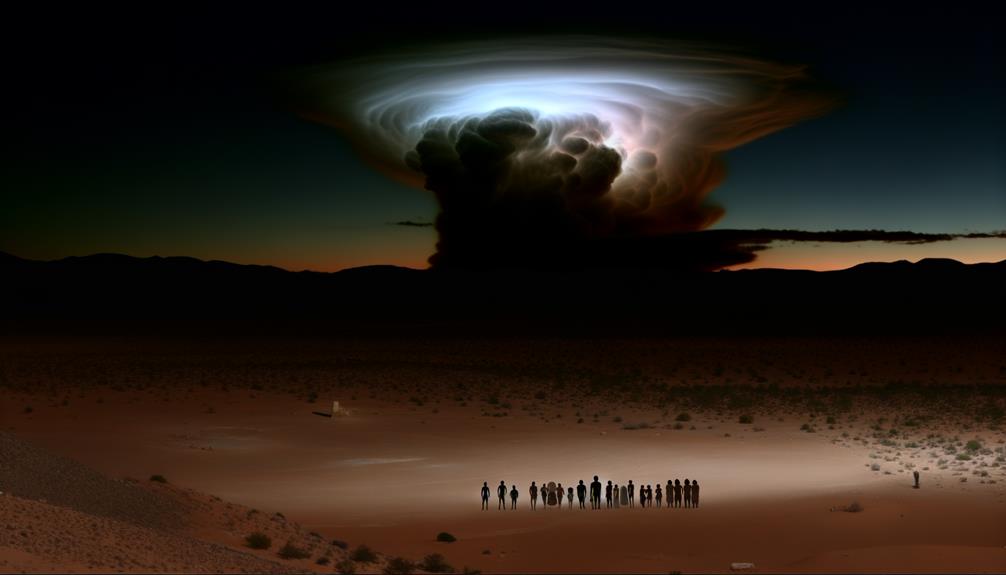
While considering the Star of Bethlehem through an astronomical lens, you'll also find intrigue in the biblical descriptions of mysterious clouds and pillars, which may similarly have natural explanations grounded in historical context. The recurrent themes of clouds and pillars not only carry deep theological significance but also reflect potential natural phenomena that were interpreted through the lens of divine interaction.
Here are three key examples that vividly illustrate these elements:
- The Pillar of Cloud and Fire: According to Exodus, this pillar guided the Israelites through the wilderness, symbolizing divine presence and protection. The dual imagery of cloud and fire could be seen as a metaphor for divine guidance, both obscuring and enlightening the path ahead.
- The Cloud on Mount Sinai: When Moses received the Ten Commandments, the mountain was covered in a thick cloud, which can be interpreted as the manifestation of God's awesome power and mystery. This cloud, enveloping the peak, might symbolize the boundary between the divine and the human.
- The Pillar of Salt: While not a cloud, the transformation of Lot's wife into a pillar of salt for looking back at Sodom serves as a stark emblem of disobedience and the weighty consequences of defying divine command.
These instances show how pillar symbolism and cloud meanings within the biblical narrative serve not only as descriptions of physical phenomena but also as profound metaphors for spiritual lessons and divine interaction.
Jacob's Ladder: A Celestial Portal?
Jacob's Ladder, often depicted as a bridge between Earth and heaven, beckons us to ponder its potential role as a celestial portal within biblical narratives. In the story, this ladder appears in Jacob's dream, providing a vivid pathway lined with ascending and descending angels, linking the divine and the terrestrial. Here, you might explore the ladder not just as a physical structure but as a profound symbol rich in dream symbolism and spiritual metaphors.
The imagery of a ladder reaching to the heavens invites you to investigate its dual representation. Initially, it symbolizes communication and connection between the higher spheres and our earthly existence, suggesting a bridge or portal of sorts. Secondly, the ladder acts as a metaphor for Jacob's own spiritual journey and evolution, reflecting personal enlightenment and the pursuit of divine knowledge.
Delving deeper, the narrative's placement of this vision in a dream underscores the importance of dreams in divine-human interaction. Dreams in biblical contexts often transcend mere sleep-induced visions; they are depicted as mediums through which the divine imparts wisdom and guidance. Therefore, Jacob's Ladder could be envisioned as a channel through which celestial beings not only traverse but also communicate profound spiritual truths to mankind. In your contemplation of this passage, it's worthwhile to explore both its literal and metaphorical implications within the broader tapestry of biblical extraterrestrial themes.
Sodom and Gomorrah: Extraterrestrial Intervention?
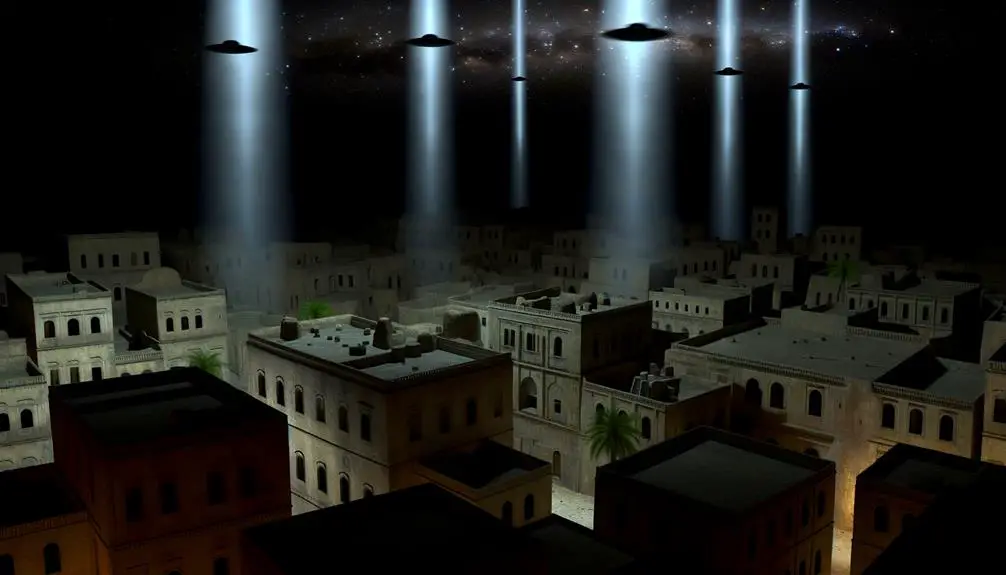
Often, scholars have speculated whether the destruction of Sodom and Gomorrah involved extraterrestrial intervention, examining the narrative through a lens of divine judgment interwoven with potential cosmic influences. The biblical account describes the cities being obliterated by brimstone and fire from the sky, an event that traditional interpretations attribute to divine punishment. Yet, you might ponder if there's more to this story, especially when integrating modern understandings of cosmic phenomena.
Consider these elements to visualize the scene:
- A Fiery Sky: Imagine the heavens ablaze, with not just meteoric fireballs but a sustained shower that paints a vivid tableau of destruction.
- Resounding Booms: The soundscape filled with thunderous roars, possibly akin to massive explosions, reverberating across the valley.
- Desolate Aftermath: Post-destruction, the land lies barren, enveloped in a thick layer of ash and smoke, hinting at a catastrophic event with extensive reach.
Archaeological evidence has occasionally been interpreted to suggest a real historical basis for such an apocalyptic event, possibly linked to a meteor strike or other significant astronomical event. This interpretation doesn't diminish the role of divine punishment but rather recontextualizes it within a possibly broader, cosmic framework. Such a perspective invites a nuanced exploration of ancient texts and modern scientific findings, intertwining faith with the wonders of the universe.
Frequently Asked Questions
How Do Modern Theologians View Extraterrestrial Theories in Biblical Contexts?
You'll find that modern theologians often approach these theories with theological skepticism, engaging in interdisciplinary dialogue to explore their implications while respectfully analyzing their fit within traditional biblical interpretations.
Are There Biblical Texts That Contradict Extraterrestrial Interpretations?
You'll find that biblical texts emphasize divine origin and lack direct references to extraterrestrials, suggesting contradictions with such interpretations upon mythological analysis. This scholarly view respects the historical and cultural context of the scriptures.
How Does Translation Affect Understanding of Possible Extraterrestrial References?
Translation nuances of ancient languages and scholarly biases can obscure or alter meanings, impacting your understanding of texts that might be interpreted as referencing extraterrestrials. It's crucial to ponder these factors critically.
What Role Do Cultural Contexts Play in Interpreting Biblical Extraterrestrials?
You're delving into how historical influences and interpretive methodologies shape our understanding. Cultural contexts significantly inform interpretations, potentially revealing more about our ancestors' worldviews than about actual otherworldly beings in the scriptures.
Have Any Major Religions Officially Addressed Extraterrestrial Theories?
You've asked whether major religions have officially addressed extraterrestrial theories. Religious declarations vary, with some leaders discussing them lightly. Interfaith perspectives also diverge, reflecting broader uncertainties about integrating such concepts with traditional beliefs.



Sign up